Market Response and Marketing Mix Models: Trends and Research Opportunities
By Douglas Bowman, Emory University, USA, Doug_Bowman@bus.emory.edu | Hubert Gatignon, INSEAD, Boulevard de Constance, France, hubert.gatignon@insead.edu
Abstract
Market response models help managers understand how customers collectively respond to marketing activities, and how competitors interact. When appropriately estimated, market response models can be a basis for improved marketing decision-making. Market response models can be broadly classi.ed as: (a) those directly linking marketing stimuli or more generally relevant inputs to market response outputs; and (b) those that also model a mediating process. Inputs include marketing instruments (i.e., marketing mix variables) and environmental variables. This monograph takes a forward-looking perspective, including trends, to identify research opportunities related to market response and marketing mix models as falling under four broad areas: (1) "New" or under-studied inputs and/or "richer" measures of inputs constructs; (2) Explicitly accounting for the process linking inputs to outputs; (3) "New" or under-studied dependent variables; and (4) Under-studied or emerging contexts.
Market Response and Marketing Mix Models
Market Response and Marketing Mix Models takes a forward-looking perspective identifying research opportunities related to market response and marketing mix models falling under four broad areas: "New" or under-studied inputs and/or "richer" measures of inputs constructs; Explicitly accounting for the process linking inputs to outputs; "New" or under-studied dependent variables; Under-studied or emerging contexts. Each section covers three broad areas related to marketing mix models – data issues and requirements, methodologies (i.e., traditional econometrics; Bayesian methods; structural models), and substantive findings. As quantitative information about markets and marketing actions has become widely available, modern marketing is presented with both a challenge and an opportunity: how to analyze this information accurately and efficiently, and how to use it to enhance marketing productivity. Market Response and Marketing Mix Models describes the tools needed for achieving these objectives.
